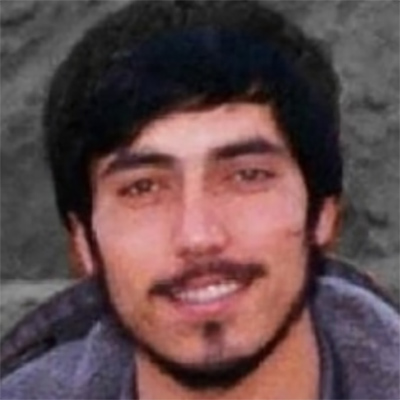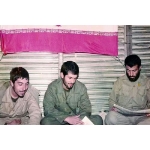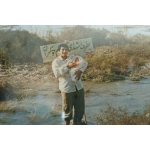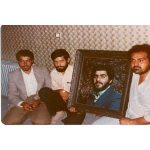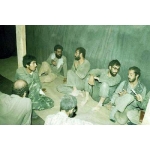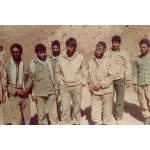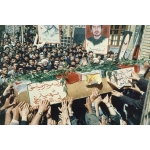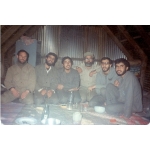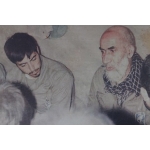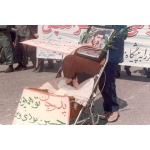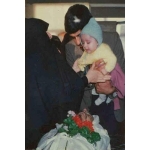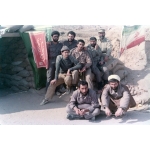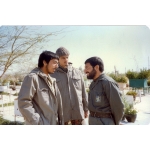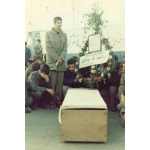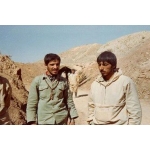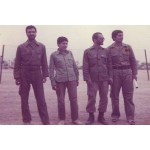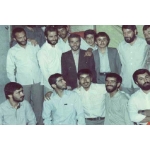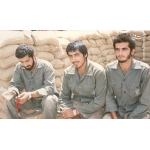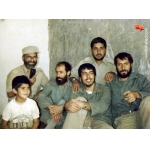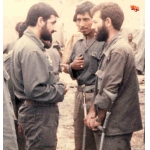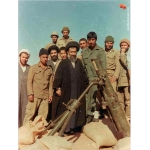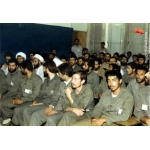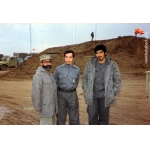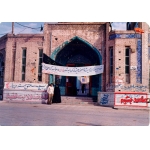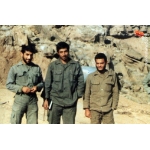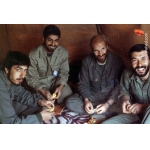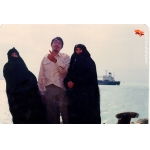Valiollah Cheraghchi Masjidi
Behnaz Baghirpour
272 بازدید
Valiollah Cheraghchi Masjidi served as the deputy commander of the 5th Nasr Division of the Islamic Revolutionary Guard Corps (IRGC) Ground Forces during the Iran-Iraq War. Valiollah was the third son of the Cheraghchi family[1]. He was born on October 23, 1958, in Mashhad to parents Gholamreza and Fakhri.[2] His grandfather was responsible for lighting the lamps of the mosque and the Holy Shrine of Hazrat Reza (PBUH) at dawn, earning the nickname Cheraghchi (meaning ‘lamp-lighter’).
As a child, Cheraghchi attended a religious Naqaviyeh, where he studied for three years. He studied mathematics at Danesh Bozorgnia High School, later known as Ferdowsi. In 1978-1979, he participated in the national university entrance exam and was accepted in the field of science engineering at the University of Birjand.[3]
With the rise of the Islamic Revolution, Cheraghchi engaged in religious political activities, establishing connections with scholars from Mashhad. It was at this time he became acquainted with Mahmoud Kaveh. In 1978-1979, when the universities closed, Cheraghchi joined the newly formed Revolutionary Guard and left the university. When unrest broke out in Gonbad, he went to the region.[4]
On December 30, 1983, Imam Khomeini officiated Cheraghchi’s marriage[5] to Tahmineh Erfanian.[6] The result of this marriage was a girl named Fatemeh,[7] born on October 29, 1984.[8]
With the onset of the Imposed War, Cheraghchi went to the battlefields.[9] His responsibilities on the front included being a battalion commander, Head of Planning and Operations of the 21st Imam Reza Brigade, Commander of the 21st Imam Reza Brigade, Head of Planning and Operations of the 6th District of the IRGC, Commander of the 6th District of the IRGC, Commander of the 5th Nasr Division of Khorasan, and Deputy Commander of the 5th Nasr Division.[10]
Cheraghchi, during Operation Nasr on September 2, 1981, which was carried out with the aim of liberating Bostan, commanded one of the expeditionary battalions of the Khorasan Corps.[11] During Operation Tariq al-Quds (Liberation of Bostan), which was carried out on November 29, 1981, his plan for capturing that area was approved by senior war commanders.[12] On February 6, 1982, in the Bostan region,[13] while he was in charge of the operations of the 21st Imam Reza Brigade,[14] Cheraghchi was injured in the hands and feet.[15]
After the martyrdom of Mohammad Mehdi Khadem al-Sharia on May 21, 1982,[16] Cheraghchi took command of the 21st Imam Reza Brigade.[17] During Operation Ramadan, which was carried out on July 13, 1982, he was wounded in several areas.[18] In Operation Muslim ibn Aqil, which was conducted on October 1, 1982, with the command of the 21st Imam Reza Brigade, he succeeded in capturing, securing, and defending the axis of Haidak, Saydak, and Darvazeh without coming into conflict in the southern front of the Sumar region.[19]
In the prelude to Operation Valfajr,[20] in February 1983, the 21st Imam Reza Brigade, under the command of Cheraghchi, took action.[21] In Operation Valfajr I, which was carried out in April 1983, he was present as the head of operations for the 5th Nasr Division in the war.[22] During Operation Valfajr 4, which was carried out in October and November of 1983 in the Dasht-e-Shiller region, he was one of the Commanders of Planning and Operations of the Khatam-ol-Anbia Central Headquarters.[23] He simultaneously served as the Deputy Head of Planning and Operations for the 5th Nasr Division.[24]
In the end, Cheraghchi, while serving as the Deputy Commander of the 5th Nasr Division of Khorasan, was wounded by a bullet to the head during Operation Badr on March 10, 1985. As a result, he was hospitalized at the Shohada Hospital in Tehran. After 23 days in a coma, on April 7, 1985, he was martyred. His body was taken to Mashhad where he was buried in the Golzar-e Shohada of Imam Reza Cemetery.[25]
In addition to a street being named after him in the Hafez neighborhood in District 9 of Mashhad, a high school was also named after him in the Vali Asr neighborhood.[26] On February 22, 2017, coinciding with Martyrs’ Day, a prominent portrait of Martyr Valiollah Cheraghchi was unveiled at the Qaem Hospital in Mashhad.[27]
Several audio files of Cheraghchi’s conversations during the war have been uploaded to the website of the Center for Sacred Defense Documents and Research.[28] The books "Cheraghchi: As Told by His Wife," "The Wrath of Chazabeh," and "The Highlights from the Life of Brigadier General Valiollah Cheraghchi Masjidi" for adults, as well as the books "The Listening Cane," "Everlasting Figures Vol. 19," and "Celestial Faces Vol. 16" for children and adolescents, have described the memories of his family and companions. The book "Vali Mehr" is a collection of poems dedicated to him.
[1] Hashemi, Seyyed Hadi, Qahr Chezabeh, Mashhad: Shadrang, [2002], p. 17.
[2] The Dictionary of Martyrdom Declaration, Vol. 25: Khorasan Razavi Province 1, p. 415.
[3] Erfanian, Maryam, Episodes from the life of Brigadier General Valiollah Cheraghchi Masjedi, Mashhad: Imanpour, 2019, p. 8.
[4] Ibid,. p. 9.
[5] Davoudi, Mahdieh, Cheraghchi, narrated by the martyr's wife, Tehran: Revayat Fath, 2004, p. 18.
[6] Ibid,. p. 8.
[7] Erfanian, Maryam, Episodes from the life of Brigadier General Valiollah Cheraghchi Masjedi, p. 10.
[8] Mousavi, Seyyed Saeed, Dictionary of Immortals of History, Volume 7: Biographies of Martyr Commanders of Khorasan Province, Tehran: Shahed Publications, 2003, p. 210.
[9] Ibid,. p. 210.
[10] Ibid,.
[11] Razzaqzadeh, Amir, Nabard Tarigh Al-Qods, Tehran: Islamic Revolutionary Guard Corps, Sacred Defense Documentation and Research Center, 2012, p. 212.
[12] Sarv Monthly, 2021, April, 15, p. 43.
[13] Hashemi, Seyyed Hadi, Qahr Chazabeh, p. 158.
[14] Ibid,. p. 47.
15 Mousavi, Seyyed Saeed, Dictionary of Immortals of History, Volume 7: p. 211.
[16] Ibid. p. 211.
[17] Sarv Monthly, ibid., p. 43.
[18] Hashemi, Seyyed Hadi, Qahr Chazabeh, p. 84.
[19] Lotfollahzadegan, Alireza, Iran-Iraq War Calendar, Book Twenty-One: Muslim Bin Aqil's Operation, Tehran: Islamic Revolutionary Guard Corps, Sacred Defense Documents and Research Center, 2013, pp. 592 and 593.
[20] Lotfollahzadegan, Alireza, Iran-Iraq War Calendar, Book Twenty-One: Muslim Bin Aqil's Operation, Tehran: Islamic Revolutionary Guard Corps, Sacred Defense Documents and Research Center, 2013, p. 17.
[21] Ibid,. p. 540.
[22] Sarv Monthly, ibid., p. 43.
[23] Nemati, Yaqoub, Karimi, Hojjatollah and Akbarpour, Mohammad Javad, Iran-Iraq War Calendar, Book Twenty-Seventh: Preparations for Operation Valfajr 4, Tehran: Islamic Revolutionary Guard Corps, Sacred Defense Documents and Research Center, 2015, p. 669.
[24] Lotfollahzadegan, Alireza, Hemmati, Iraj, Iran-Iraq War Calendar, Book Twenty-Eight: The First Major Operation in the Northwest of Fajr 4, Tehran: Islamic Revolutionary Guard Corps, Sacred Defense Documents and Research Center, 2017, p. 764.
[25] Erfanian, Maryam, Episodes from the life of Martyr Brigadier General Valiollah Cheraghchi Masjedi, p. 1.
[26] https://neshan.org/maps/places
[27] Martyr and Veterans Affairs Foundation Information Database, Article Code 200359, 8 May 2022
/https://www.isaar.ir
[28] https://defamoghaddas.ir


